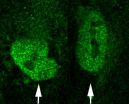(Press-News.org) COLUMBUS, Ohio – A new study could provide the link that scientists have been looking for to confirm that reactivation of a latent herpes virus is a cause of some heart problems.
Looking at blood samples from 299 heart patients, researchers at Ohio State University found that those who had suffered a heart attack were the most likely to have inflammatory proteins circulating in their blood compared to patients with less acute symptoms. And having more of one of these proteins in the blood was linked to the presence of antibodies that signal a latent Epstein-Barr virus (EBV) reactivation.
To date, these relationships have been hard to find because scientists have been unable to detect evidence of a virus in diseased areas of the cardiovascular system.
In this study, however, the researchers instead looked for antibodies against a protein that can be produced even when only partial or incomplete reactivation of Epstein-Barr EBV occurs. And when this antibody was detected, it was associated with immune system malfunctions connected to inflammation – a known risk factor for heart disease.
Identifying a solid link between a reactivated virus and heart disease is important because of the prevalence of EBV, a human herpes virus that causes infectious mononucleosis and several different types of tumors. An estimated 95 percent of Americans have been infected with the virus by adulthood, and once a person is infected, the virus remains dormant in the body. It can be reactivated without causing symptoms of illness, but reactivation has potential to create chaos in the immune system.
Stress is a known predictor of reactivation of EBV, meaning virus reactivation could be a mechanism by which stress leads to chronic inflammation and eventually cardiovascular diseases.
"In the big picture, this may help clarify the role these viruses play in heart disease," said co-author Ron Glaser, director of Ohio State's Institute for Behavioral Medicine Institute (IBMR) and professor of molecular virology, immunology and medical genetics. "And it makes sense, because we know that some viral proteins can induce inflammation, affecting the lining of blood vessels, so that inflammation is in the right place to function as a significant risk factor for heart disease."
The research is published in the online journal PLOS ONE.
The patients whose blood was sampled for the study were undergoing angioplasty to clear narrow arteries. Researchers tested their blood for the presence of numerous cytokines – proteins that signal the presence of inflammation – as well as for antibody to an EBV encoded viral protein called dUTPase. This protein is produced early in the process of viral reactivation, and may be present even if signs of the virus itself cannot be detected.
Co-author Marshall Williams, professor of molecular virology, immunology and medical genetics, uses a highly sensitive method to detect these antibodies, and hopes to develop an equally effective technique that could be put to use in clinical laboratories.
Patients who had had acute myocardial infarction – a heart attack – were the most likely to have the highest measures of two cytokines, interleukin-6 (IL-6) and intercellular adhesion molecule 1 (ICAM-1) in their blood compared to patients whose main symptom was chest pain.
Researchers also identified a strong relationship between circulating concentrations of ICAM-1 and detectable antibodies to EBV dUTPase. In fact, the highest values of ICAM-1 were found in patients who had had a heart attack and were positive for the dUTPase protein. A similar trend was seen with IL-6, but the finding could have been attributed to chance.
"This study provides the essential clinical corroboration of this mechanism showing enhanced levels of proinflammatory proteins in the blood of patients with acute coronary events and detectable levels of the EBV-related protein," said Philip Binkley, professor of cardiovascular medicine and epidemiology at Ohio State and a lead author of the study.
###
Additional co-authors on this work include Glen Cooke and Amanda Lesinski of the Division of Cardiovascular Medicine; Min Chen and Bryon Laskowski of the IBMR; James Waldman of the Department of Pathology; and Maria-Eugenia Ariza and Deborah Knight of the Department of Molecular Virology, Immunology and Medical Genetics. Co-author Mackenzie Taylor, Binkley and Cooke also are investigators in the Davis Heart and Lung Research Institute.
Contact: Philip Binkley, (614) 293-8963; Philip.Binkley@osumc.edu or Ron Glaser, (614) 293-0178; Ronald.Glaser@osumc.edu
Written by Emily Caldwell, (614) 292-8310; Caldwell.151@osu.edu
END
Muscular dystrophy is caused by the largest human gene, a complex chemical leviathan that has confounded scientists for decades. Research conducted at the University of Missouri and described this month in the Proceedings of the National Academy of Sciences has identified significant sections of the gene that could provide hope to young patients and families.
MU scientists Dongsheng Duan, PhD, and Yi Lai, PhD, identified a sequence in the dystrophin gene that is essential for helping muscle tissues function, a breakthrough discovery that could lead to treatments for the ...
NASA's Aqua satellite documented the formation of Tropical Storm Oswald in the Gulf of Carpentaria on Jan. 21 and the landfall on Jan. 22 in the southwestern Cape York Peninsula of Queenstown, Australia. Oswald has since become remnant low pressure area over land.
Tropical Storm Oswald was hugging the southwestern coast of the Cape York Peninsula, Queensland, Australia when NASA's Aqua satellite first flew overhead on Jan. 21 at 0430 UTC (Jan. 20 at 11:30 p.m. EST). The Moderate Resolution Imaging Spectroradiometer (MODIS) instrument aboard NASA's Aqua satellite captured ...
Jan. 22, 2013 - A common type of bacteria may help pigs stay healthy during weaning.
In a study of 36 weanling-age pigs, researchers found that a dose of lipid-producing Rhodococcus opacus bacteria increased circulating triglycerides. Triglycerides are a crucial source of energy for the immune system.
"We could potentially strengthen the immune system by providing this bacterium to animals at a stage when they are in need of additional energy," said Janet Donaldson, assistant professor in Biological Sciences Mississippi State University. "By providing an alternative ...
A novel software tool, developed at The Children's Hospital of Philadelphia, streamlines the detection of disease-causing genetic changes through more sensitive detection methods and by automatically correcting for variations that reduce the accuracy of results in conventional software. The software, called ParseCNV, is freely available to the scientific-academic community, and significantly advances the identification of gene variants associated with genetic diseases.
"The algorithm we developed detects copy number variation associations with a higher level of accuracy ...
This flu season you've probably seen a number of friends on social media talking about symptoms.
New research from Brigham Young University says such posts on Twitter could actually be helpful to health officials looking for a head start on outbreaks.
The study sampled 24 million tweets from 10 million unique users. They determined that accurate location information is available for about 15 percent of tweets (gathered from user profiles and tweets that contain GPS data). That's likely a critical mass for an early-warning system that could monitor terms like "fever," ...
NEW BRUNSWICK, N.J. – Coming out to one's family can be stressful, but gay black males face a unique set of personal, familial and social challenges.
"Parents and youths alike worry that gay men cannot meet the rigid expectations of exaggerated masculinity maintained by their families and communities," says Michael C. LaSala, director of the Master of Social Work program at Rutgers University School of Social Work. LaSala, an associate professor, recently completed an exploratory study of African American gay youth and their families from urban neighborhoods in New York ...
BUFFALO, N.Y. – New University at Buffalo research demonstrates how defects in an important neurological pathway in early development may be responsible for the onset of schizophrenia later in life.
The UB findings, published in Schizophrenia Research (paper at http://bit.ly/Wq1i41), test the hypothesis in a new mouse model of schizophrenia that demonstrates how gestational brain changes cause behavioral problems later in life – just like the human disease.
Partial funding for the research came from New York Stem Cell Science (NYSTEM).
The genomic pathway, called the ...
NEW YORK (January 22, 2013) -- A research study of more than 600 black patients with uncontrolled hypertension found that less than half were prescribed a diuretic drug with proven benefit that costs just pennies a day, report researchers at Weill Cornell Medical College and the Visiting Nurse Service of New York's (VNSNY) Center for Home Care Policy and Research. The researchers say these new findings should be taken as a serious wake-up call for physicians who treat black patients with hypertension.
Their study, reported in the American Journal of Hypertension, found ...
ALEXANDRIA, Va. – New research into the treatment and prognosis of gastrointestinal cancers was released today in advance of the tenth annual Gastrointestinal Cancers Symposium being held January 24-26, 2013, at The Moscone West Building in San Francisco, CA.
Five important studies were highlighted today in a live presscast:
Postoperative Treatment with S-1 Chemotherapy Reduces Relapses and Extends Survival in Patients with Pancreatic Cancer: Early results from a Phase III clinical trial conducted in Japan show patients who received the chemotherapy drug S-1 after ...
HOUSTON — Marked for death with molecular tags that act like a homing signal for a cell's protein-destroying machinery, a pivotal enzyme is rescued by another molecule that sweeps the telltale targets off in the nick of time.
The enzyme, called TRAF3, lives on to control a molecular network that's implicated in a variety of immune system-related diseases if left to its own devices.
The University of Texas MD Anderson scientists identified TRAF3's savior and demonstrated how it works in a paper published online Sunday in Nature.
By discovering the role of OTUD7B as ...

